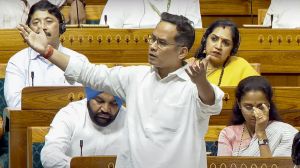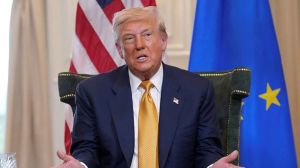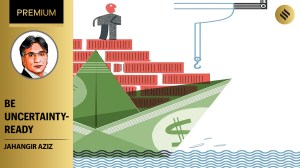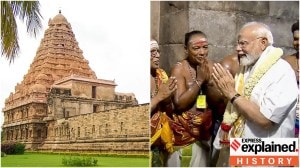UPSC Key: Shimla Agreement, Attari-Wagah border and Global Pandemic Treaty
Why role of external state and non-state actors in creating challenges to internal security is relevant to the UPSC exam? What is the significance of topics such as South Asian Association for Regional Cooperation (SAARC) Visa Exemption Scheme (SVES), escalation ladder and cross-border infiltration on both the preliminary and main exams? You can learn more by reading the Indian Express UPSC Key for April 25, 2025.
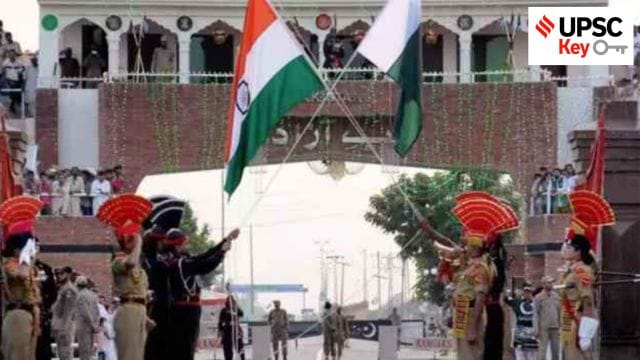 UPSC Key April 2025: Here's what you should be reading from the April 24, 2025 edition of The Indian Express
UPSC Key April 2025: Here's what you should be reading from the April 24, 2025 edition of The Indian Express Important topics and their relevance in UPSC CSE exam for April 25, 2025. If you missed the April 24, 2025 UPSC CSE exam key from the Indian Express, read it here
FRONT PAGE
Indus abeyance is official, all visas cancelled: Delhi turns the screws
Syllabus:
Preliminary Examination: Current events of national and international importance.
Main Examination:
• General Studies II: India and its neighbourhood- relations.
• General Studies II: Bilateral, regional and global groupings and agreements involving India and/or affecting India’s interests.
• General Studies III: Role of external state and non-state actors in creating challenges to internal security.
What’s the ongoing story: RESPONDING to the Pahalgam terror attack, a day after it put the Indus Waters Treaty (IWT) on hold, downgraded diplomatic ties and shut the Attari-Wagah border, India ratcheted up the pressure on Pakistan.
Key Points to Ponder:
• The 2025 Pahalgam terror attack—What is the present situation?
• The 5-Point Action Plan Announced by India After the Pahalgam Terror Attack—What is that?
• What is South Asian Association for Regional Cooperation (SAARC) Visa Exemption Scheme (SVES)
• What is the Shimla Agreement?
• What is the ceasefire agreement between India and Pakistan?
• Which militant group claimed responsibility for the 2025 Pahalgam terror attack?
• What are the immediate diplomatic action did India take following the Pahalgam terror attack?
• What are non-state actors ?
• Who are the non-state actors in India?
• Know the role of external state and non-state actors in creating challenges to internal security with reference to the Pahalgam terror attack.
Key Takeaways:
• India formally informed Pakistan that New Delhi has decided the IWT be held in abeyance with immediate effect. It also decided to cancel all existing visas to Pak nationals with effect from April 27 and suspend visa services for them.
• This move, a day after cancelling visas under a special SAARC scheme, will impact Pak nationals who come to India for medical treatment and those who visit their pre-Partition divided families.
• Additionally, New Delhi advised its nationals to avoid travelling to Pakistan and asked those still there to return.
• On Wednesday, India had also expelled diplomats and top defence officials from the Pakistan High Commission effectively halving the mission strength.
• It withdrew its own advisors and staff from its mission in Islamabad.
• Thursday’s retaliation, after the Pahalgam attack that killed 25 tourists and one local resident Tuesday, is the strongest since the abrogation of Article 370 in 2019. The Pahalgam attack is also the deadliest terror attack on civilians in India, since the 26/11 Mumbai terror attack.
• In tandem, Foreign Secretary Vikram Misri briefed a group of foreign ambassadors in the Ministry of External Affairs — part of Delhi’s coercive diplomacy to further isolate Pakistan and increase international pressure to bear on it. Delhi has underlined “the cross-border linkages of the terrorist attack.”
• Prime Minister got calls from French President Emmanuel Macron, Italian PM Giorgia Meloni, Israel PM Benjamin Netanyahu, Egyptian President Abdel Fatah el-Sisi among others over the Pahalgam attack.
Do You Know:
• In a statement, the MEA said all existing valid visas issued by India to Pak nationals stand revoked with effect from April 27, 2025. It added that medical visas issued to Pak nationals will be valid only till April 29, 2025. “All Pakistani nationals currently in India must leave India before the expiry of visas, as now amended,” it said.
• This came a day after Misri had said that “Pakistani nationals will not be permitted to travel to India under the SAARC Visa Exemption Scheme (SVES) visas. Any SVES visas issued in the past to Pakistani nationals are deemed cancelled.”
• The SVES was launched in 1992 after leaders at the Fourth Summit (Islamabad, 29-31 December 1988), realising the importance of having people-to-people contact among SAARC countries, decided that certain categories of dignitaries should be entitled to a special travel document.
As directed by the Summit, the Council of Ministers regularly kept under review the list of entitled categories. Currently, the list includes 24 categories which include dignitaries, judges of higher courts, Parliamentarians, senior officials, businessmen, journalists,
sportspersons.
• Visa stickers are issued by the respective Member States to the entitled categories of that particular country. The validity of the Visa Sticker is generally for one year. The implementation is reviewed regularly by Immigration authorities of SAARC member states.
Other Important Articles Covering the same topic:
📍Explained: What Is the Saarc Visa Scheme and Why India Just Suspended It for Pakistan
Previous year UPSC Main Question Covering similar theme:
📍“Increasing cross-border terrorist attacks in India and growing interference in the internal affairs of several member-states by Pakistan are not conducive for the future of SAARC (South Asian Association for Regional Cooperation).” Explain with suitable examples. (2016)
Managing escalation in Delhi: Uncharted waters, a new compass
Syllabus:
Preliminary Examination: Current events of national and international importance.
Main Examination: General Studies II: India and its neighbourhood- relations.
What’s the ongoing story: C Raja Mohan writes: For India, managing the military escalation ladder, knowing when and how to terminate the escalation, leveraging the international community, sharpening the internal contradictions in Pakistan will be the key to its effective use of force against the entrenched terror infrastructure across the border
Key Points to Ponder:
• What internal challenges within Pakistan are highlighted in the given article as strategic leverage points for India?
• How has the global diplomatic landscape shifted in favour of India, according to the article?
• What you understand by the concept of the “escalation ladder” in the context of India-Pakistan relations?
• How media narratives in India and Pakistan post-Pahalgam attack have influenced public perception and bilateral relations.
• What is ‘false flag operation’?
• Assess the influence of media narratives on policy decisions taken by India and Pakistan in the aftermath of the Pahalgam attack.
• Compare and contrast the defense capabilities of India and Pakistan in 2025.
• Analyse the economic disparities between India and Pakistan in 2025, emphasizing GDP, foreign exchange reserves, and purchasing power parity.
Key Takeaways:
C Raja Mohan writes:
• In many a Kashmir crisis, a frequent invocation has been: “aar ya paar” — or the decisive final battle — between the two nations. Yet, each time, India and Pakistan have walked back from the brink.
• After the brutal terror attack in Pahalgam Tuesday, the old ghosts hardly buried, new ones are conjuring.
• All Indian Prime Ministers, in the last four decades, have been frequently tested by a military crisis with Pakistan. Prime Minister Narendra Modi has faced more than one. But the current crisis could be far more demanding
• To be sure, Delhi’s overall national power has grown in relation to Islamabad—India’s GDP at $4 trillion, for example, is 10 times larger than Pakistan’s. Delhi’s global diplomatic influence now overshadows Islamabad’s—many traditional friends of Pakistan are now neutral if not tilted towards India. Pakistan is more internally divided than ever and its western borders with Afghanistan restive.
• Yet, there are many imponderables that Modi must deal with, including the significant capabilities of the Pakistan Army. But given the horrific nature of the attack and the outrage that has convulsed the nation, the PM may have no option but to explore some major risks.
• The border shutdowns, suspension of trade, the closing of air space, and the downgrading of the two high commissions are all reversible at some point.
• But Islamabad’s framing of the possibility of India blocking the flow of river waters into Pakistan as an “act of war,” and its decision to reserve the right to suspend all previous agreements, including the 1972 Shimla Agreement, is entering uncharted territory.
Do You Know:
C Raja Mohan writes:
• Every round of conflict between India and Pakistan inevitably changed some things on the ground. Yet some elements of the relationship, such as the Indus Water Treaty, endured. Although Pakistan has long given up on the Shimla agreement, it has never formally discarded it. In other words, the slate of accumulated agreements and understandings between the two nations could well be erased as this crisis escalates.
• India’s use of force must be carefully planned and executed at a time and place of its choice to produce maximum effects on the Pakistan army. It will come sooner than later. The question is only about its quality and purpose.
• Delhi has seen Beijing step in vigorously in favour of Pakistan in the wake of India’s 2019 constitutional amendments on Kashmir. China not only sought to put the issue on the agenda of the United Nations Security Council but also moved to unilaterally change the line of actual control in Ladakh in the spring of 2020.
• For India, managing the military escalation ladder, knowing when and how to terminate the escalation, leveraging the international community, sharpening the internal contradictions in Pakistan will be the key to its effective use of force against the entrenched terror infrastructure across the border.
Other Important Articles Covering the same topic:
Pakistan suspends trade with India, says diverting Indus water ‘an act of war’, closes air space
Syllabus:
Preliminary Examination: Current events of national and international importance.
Main Examination:
• General Studies II: India and its neighbourhood- relations.
• General Studies II: Bilateral, regional and global groupings and agreements involving India and/or affecting India’s interests.
• General Studies III: Role of external state and non-state actors in creating challenges to internal security.
What’s the ongoing story: A day after India took several diplomatic measures against Pakistan over the Pahalgam terror attack, Islamabad said Thursday it “shall exercise the right to hold all bilateral agreements with India, including but not limited to the Simla Agreement, in abeyance.”
Key Points to Ponder:
• What can be the economic implications of Pakistan’s airspace closure on Indian airlines and the broader aviation industry.
• How geopolitical tensions can impact civil aviation, with reference to the recent airspace closure between India and Pakistan?
• What is the primary reason for the increased operational costs for Indian airlines due to Pakistan’s airspace closure?
• How airspace closures can affect cargo transport and supply chain logistics for Indian exporters and importers.
• Evaluate the operational challenges faced by airlines due to sudden airspace restrictions and suggest mitigation strategies.
Key Takeaways:
• India put on hold the Indus Waters Treaty, downgraded diplomatic relations with Pakistan, expelled diplomats and top defence officials from the Pakistan High Commission in Delhi, cancelled all visas granted to Pakistan nationals and directed them to leave the country in 48 hours, and shut the Attari-Wagah border.
• The reaction from Pakistan came after the country’s Prime Minister Muhammad Shehbaz Sharif chaired a meeting of the National Security Committee (NSC).
• A statement from its Prime Minister’s Office said Pakistan “vehemently rejects the Indian announcement to hold the Indus Waters Treaty in abeyance” and any attempt to stop or divert the flow of water belonging to Pakistan as per the Indus Waters Treaty, and the usurpation of the rights of lower riparian will be considered as “an Act of War”.
• “Pakistan’s airspace will be closed with immediate effect for all Indian owned or Indian operated airlines… all trade with India, including to and from any third country through Pakistan, is suspended forthwith.”
• It also said that it will be shutting down the Wagah border post, and reducing the strength of the High Commission to 30 and expelling the Defence services officials from the Indian High Commission, in a tit-for-tat move.
Do You Know:
• With Pakistan closing off its airspace to Indian carriers on Thursday, airlines now face longer durations and higher fuel burn for westward international flights taking off from north India — factors that could lead to a hike in airfares.
• The Indian Express’s review of recent flight paths of numerous international flights departing from the Delhi airport suggests Pakistan’s retaliatory action will affect Indian carriers’ flights to Central Asia, the Caucasus, West Asia, Europe, the UK and North America.
• According to industry insiders, while it is still too early to assess the impact, the airlines’ costs are bound to rise and could translate into higher airfares. Additionally, as airlines from other countries can continue to overfly Pakistan, they may get a cost advantage over Indian airlines on the affected routes.
• The last time Pakistan closed its airspace for an extended period — in 2019, following the Balakot airstrikes — Indian airlines lost around `700 crore owing to higher fuel expenses and operational complications that came with the longer routes.
• Air India was the worst-affected Indian carrier at the time, as it operated more west-bound international flights than other airlines. It was and continues to be the only Indian airline that operates long-haul and ultra-long-haul flights to Europe and North America.
• Following the Indian Air Force’s airstrikes in Balakot, Pakistan had fully closed its airspace on February 26, 2019. It eventually fully opened its airspace for overflying in July 2019. By June, Indian airlines’ collective loss due to the airspace closure was pegged at more than `550 crore, according to data furnished by the Ministry of Civil Aviation at the time. The figure, according to industry insiders, was around `700 crore till mid-July of that year, when Pakistan completely removed the restrictions.
• In 2019, due to Pakistan’s closure of routes, most flights saw their durations rise by at least 70-80 minutes. Air India’s flights from Delhi to Chicago had to stop in Europe for refuelling. Further, IndiGo’s flight from Delhi to Istanbul, which was then being operated by narrow-body aircraft, had to make a refuelling stop at Doha.
Other Important Articles Covering the same topic:
J&K TERROR ATTACK
Attari border closure to hit `3,800-cr Indo-Pak trade
Syllabus:
Preliminary Examination: Current events of national and international importance.
Main Examination:
• General Studies II: India and its neighbourhood- relations.
• General Studies II: Bilateral, regional and global groupings and agreements involving India and/or affecting India’s interests.
What’s the ongoing story: India’s decision to close the Integrated Check Post (ICP) at Attari with immediate effect, in the wake of the Pahalgam terror attack, is set to halt cross-border trade worth Rs 3,886.53 crore between India and Pakistan.
Key Points to Ponder:
• Map Work—Attari–Wagah border
• Why the Attari-Wagah Border is important?
• Know the strategic and economic significance of the Attari-Wagah border in the context of India-Pakistan relations.
• What could be the impact of the closure of the Attari-Wagah border on regional trade dynamics, particularly concerning Afghanistan?
• Know the role of cultural exchanges at the Attari-Wagah border in fostering people-to-people ties between India and Pakistan.
• How the suspension of operations at the Attari-Wagah border affects local economies and communities on both sides?
Key Takeaways:
• Bilateral trade had already been in decline since India imposed a 200 per cent duty on Pakistani goods in 2019, following the Pulwama terrorist attack, data from the Land Ports Authority of India shows.
• According to official data, India exported items such as soya bean, poultry feed, vegetables, red chillies, plastic granules, and plastic yarn, while importing goods including dry fruits, dates, gypsum, cement, glass, rock salt, and herbs from Pakistan via the Land Port at Attari. The port, spread over 120 acres, assumes significance since it has direct access to National Highway 1.
• Tensions between the two countries — particularly following the Pulwama attack — reduced trade between India and Pakistan from Rs 4,370.78 crore in 2018–19 to Rs 2,257.55 crore in 2022–23. However, trade rebounded to Rs 3,886.53 crore in 2023–24, the highest in the past five years. Notably, total cargo movement also dropped from 49,102 consignments in 2018–19 to just 3,827 in 2022–23, the data shows.
• Straw reapers and cotton yarn are among the major export items from Indian Punjab via the Wagah–Attari land route.
“Straw reapers, manufactured by various small-scale units in Punjab, are a significant export to Pakistan through the ICP at Attari. Between 2016–17 and 2018–19, the number of straw reapers exported ranged from 846 to 1,110 units, with export earnings between Rs 1,844 lakh and Rs 2,488 lakh,” the report said.
“Due to trade restrictions, exports of straw reapers dropped to 100 units in 2019–20, with earnings falling to Rs 232 lakh. Exporters had expected to ship 2,441 straw reapers to Pakistan in 2020–21 under normal trade conditions, which could have generated Rs 6,195 lakh in revenue,” the report added.
Do You Know:
• In dollar terms, total India-Pakistan trade has shrunk to about $2 billion annually over the past five years, a small fraction of the $37 billion trade potential estimated by the World Bank. India’s overall goods trade stands at $430 billion, while Pakistan’s is approximately $100 billion.
• The aid-dependent Pakistani economy has also faced recurring bouts of high inflation following the Covid-19 pandemic and widespread social unrest. In May last year, violent street protests in Pakistan-occupied Kashmir (PoK) left one police officer dead and over 90 injured, according to Pakistani media reports.
• Trade experts noted that India-Pakistan trade via the Attari border had created a significant economic ecosystem in Punjab, particularly in and around Amritsar as well as Attari. The trade provided direct and indirect employment to thousands, including transporters, porters, shopkeepers, and workers in related industries.
• The Attari-Wagah land route was first opened in 2005 and truck movement on this route began in 2007. The ICP at Attari was inaugurated on April 13, 2012, under the UPA government, with provisions of facilities for fast and cost-effective land trade.
Other Important Articles Covering the same topic:
📍India’s 5-point action against Pakistan after Pahalgam terror attack
EXPRESS NETWORK
Consider mandating minimum vote share even for unopposed candidate: SC to Centre
Syllabus:
Preliminary Examination: Current events of national and international importance.
Main Examination: General Studies II: Salient features of the Representation of People’s Act.
What’s the ongoing story: The Supreme Court on Thursday sought to know whether it can be laid down in the election law to mandate a certain percentage of votes even when there is only one candidate in the fray for declaring him/her elected.
Key Points to Ponder:
• What recent suggestion did the Supreme Court of India make regarding unopposed elections?
• Which section of the Representation of the People Act, 1951, currently allows unopposed candidates to be declared elected without voting?
• What is the main concern of the Supreme Court regarding unopposed elections?
• What does NOTA stand for in the context of elections?
• According to the Election Commission, how has the NOTA option performed since its introduction?
• What is the primary purpose of introducing a minimum vote threshold for unopposed candidates?
Key Takeaways:
• “Will it not be a very welcome and progressive step where only one candidate is left in free [fray] and still you say that you will be declared election [elected] only when you get at least 10%, 15% (votes), whatever…,” Justice Surya Kant presiding over a two-judge bench asked the Centre and the Election Commission of India.
• “Our Constitution, and we salute it, is one of the most dynamic… It says that democracy by majority… So when we talk of the majority as the foundation stone of the democracy, why not in furtherance of achieving that very goal, we prescribe that even in a default direction, there should be at least some voters who are liking you,” Justice Kant said.
• The bench, also comprising Justice N K Singh, was hearing a plea by ‘Vidhi Centre for Legal Policy’, praying that section 53(2) of The Representation of the People Act, 1951, in so far as it applies to direct elections to Lok Sabha and state assemblies be read down or struck down as unconstitutional. The provision says that in case of an uncontested election, the Election Commission shall declare the only existing candidate as the winner forthwith without holding an election.
Do You Know:
• The Supreme Court directed the Election Commission of India (ECI) to introduce the NOTA option for voters in September 2013, in order to protect the secrecy of voters’ choice.
• In 2004 the People’s Union for Civil Liberties (PUCL) had approached the apex court seeking directions to the ECI for measures to protect the ‘right to secrecy’ of voters to exercise their franchise. They argued that the Conduct of Elections Rules, 1961 violated the secrecy aspect as the Presiding Officer (from the ECI) maintains a record of voters who choose not to vote along with the signatures or thumb impressions of each voter who exercises this right.
• Moreover, with the introduction of EVMs, the court noted that anyone present in the polling booth would know if a voter has decided not to vote, as the machine would not emit any light or sound (as it does when a vote is cast). The court noted that the ECI in 2001 sent a letter to the Ministry of Law and Justice seeking the introduction of a NOTA option in EVMs and ballot papers to protect voter secrecy as well as allow voters to “express his dissent/disapproval against the contesting candidates and will have the benefit of reducing bogus voting.”
Other Important Articles Covering the same topic:
📍Two lakh plus NOTA votes in Indore: Why NOTA was introduced, its consequences
Previous year UPSC Mains Question Covering similar theme:
📍Discuss the role of the Election Commission of India in the light of the evolution of the Model Code of Conduct. (2022)
📍To enhance the quality of democracy in India the Election Commission of India has proposed electoral reforms in 2016. What are the suggested reforms and how far are they significant to make democracy successful? (2017)
EXPLAINED
Syllabus:
Preliminary Examination: Current events of national and international importance
Main Examination: General Studies III: Security challenges and their management in border areas
What’s the ongoing story: After killing 26 tourists in Baisaran, a meadow near Pahalgam in the lap of the Pir Panjal mountains, the five terrorists are learnt to have fled to the surrounding jungles that are spread across hundreds of kilometres of rugged, difficult terrain.
Key Points to Ponder:
• What is Terrorism?
• What is cross-border infiltration?
• How India Combat Terrorism?
• What are the steps and measures taken by India to enhance its counter-terrorism efforts?
• What are the challenges faced by Indian intelligence agencies in preventing cross-border terrorist infiltrations, citing the Pahalgam incident as a case study?
Key Takeaways:
• This has left security forces with a daunting challenge — one that underlines the importance of a robust anti-infiltration grid to prevent terrorists from crossing over in the first place.
• The dense jungles in the upper reaches of the Pir Panjal range provide ample avenues to avoid detection. Sources say visibility in these jungles is so poor that it is difficult to spot movement even 100 metres away. Tracking down suspects in these parts requires robust technical and human intelligence support.
• Over the last few years, the armed forces have suffered serious casualties chasing terrorists in these jungles — more than 50 Army personnel have lost their lives in encounters with terrorists in the Poonch, Rajouri, Kathua, and Doda regions
• This is perhaps a direct consequence of Pakistan sending in highly trained terrorists, who operate in stealth and live off the jungle, into the Jammu region. Their lack of contact with locals, and use of advanced, stealthy communication devices has made it difficult to hunt them down.
• Sources say the Pahalgam terrorists were likely of this kind. At least three of the attackers are suspected to be from Pakistan.
• “Once a terrorist is in, it is not easy to hunt him down… So the idea should be to not let him enter in the first place,” a senior security establishment officer told The Indian Express.
This is why a robust counter-infiltration grid, which includes difficult-to-breach fencing, a strong intelligence network, and trained border-guarding manpower, is the need of the hour. This is more so because terror recruitment in the Valley itself is the lowest it has ever been. Chief of Army Staff General Upendra Dwivedi in January said that 60% of the 73 terrorists killed in counter-terror operations in J&K in 2024 were from Pakistan.
Do You Know:
• Data support the effectiveness of border fencing, which picked up pace after the 2003 ceasefire agreement between India and Pakistan. According to Intelligence Bureau figures, more than half of all infiltration attempts were successful in 2002. By 2010, only a fifth of the attempts (52 out of 247) met with success.
• The India-Pakistan border (including the Line of Control) is almost entirely fenced. Since 2014, there has been a push to make this fencing more robust, and plug riverine gaps in the Jammu region with technological solutions.
This received a major impetus with the Comprehensive Integrated Border Management System (CIBMS) project, launched after the 2016 Pathankot attack. The CIBMS deploys a range of state-of-the-art surveillance technologies — thermal imagers, infra-red and laser-based intruder alarms, aerostats for aerial surveillance, unattended ground sensors, radars, sonar systems for riverine borders, and fibre-optic sensors — that provide real-time surveillance data to a command and control system.
• However, it remains a work in progress. In October 2016, then Union Home Minister Rajnath Singh had announced that the India-Pakistan
border would be sealed by December 2018. Cut to December 2023, with work still pending, Home Minister Amit Shah revised the deadline to December 2025.
Progress of the CIBMS has been slowed by the non-availability of required technology and, at times, incoherent planning. Some of the suggestions floated in MHA meetings following the Pathankot attacks bordered on the bizarre.
For instance, to plug the vulnerability at riverine patches, one suggestion was to install motorised pulleys that would constantly ferry a patrolman back and forth. This was (wisely) shot down on the grounds that if the motor malfunctioned, the sentry would be left literally hanging, a sitting duck.
Other Important Articles Covering the same topic:
📍Pahalgam terror attack: Pakistan denies any role, India points out cross-border attack links
Previous year UPSC Mains Question Covering similar theme:
📍The scourge of terrorism is a grave challenge to national security. What solutions do you suggest to curb this growing menace? What are the major sources of terrorist funding? (2017)
The new global pandemic treaty: why it is needed, why it falls short
Syllabus:
Preliminary Examination: Current events of national and international importance
Mains Examination: General Studies II: Issues relating to development and management of Social Sector/Services relating to Health, Education, Human Resources
What’s the ongoing story: Following more than three years of arduous negotiations, member states of the World Health Organization (WHO) last week agreed on a draft of a legally binding treaty designed to tackle future pandemics better. The deal is expected to be ratified at the World Health Assembly in May.
Key Points to Ponder:
• What is the WHO’s new global pandemic treaty?
• Why was there a need for a global pandemic treaty?
• What does the pandemic treaty say?
• How strong is the global pandemic treaty?
• What is India’s stand on global pandemic treaty?
Key Takeaways:
• The pandemic treaty, which was agreed upon without the United States, is the only the second legally binding accord in the WHO’s 75-year history, the first being the 2003 tobacco control treaty.
• WHO Director-General Tedros Adhanom Ghebreyesus described the deal as “a significant milestone in our shared journey towards a safer world”.
• The negotiations for a global pandemic treaty began in December 2021, at a time when the Omicron variant of SARS-CoV-2 was spreading across the world and producing a massive new surge of COVID-19. By then, countries that were manufacturing COVID-19 vaccines had hoarded millions of doses, leaving those with no vaccine plants often with no access to the shots.
• A 2022 study published by the journal Nature revealed that more than one million lives could have been saved if COVID-19 vaccines had been shared more equitably with lower-income countries — the virus had claimed more than seven million lives across the world.
• A 2021 report published by the Independent Panel for Pandemic Preparedness and Response said, “The combination of poor strategic choices, unwillingness to tackle inequalities, and an uncoordinated system created a toxic cocktail which allowed the pandemic to turn into a catastrophic human crisis.”
Do You Know:
• One of the key elements of the draft agreement is a “pathogen access and benefit sharing” system, which gives pharmaceutical companies access to scientific data such as pathogen samples and genomic sequences in return for more equitable sharing of drugs, vaccines and diagnostics during a pandemic, according to a report in Nature.
• The draft treaty says participating manufacturers will have to allocate 10% of their production of vaccines, therapeutics and diagnostics to the WHO. Another 10% will then be supplied at “affordable prices”.
• Also, member states should “promote and otherwise facilitate or incentivise” the exchange of technology and know-how to help manufacturers in developing nations make their own drugs and vaccines, the draft agreement says.
• Countries also need to develop national policies for putting conditions on research into drugs and vaccines that they fund — given either to universities or companies — to guarantee “timely and equitable access” to resulting drugs or diagnostics during pandemics.
Other Important Articles Covering the same topic:
Previous year UPSC Prelims Question Covering similar theme:
1. In the context of vaccines manufactured to prevent Covid-19 pandemic, consider the following statements: (2022)
1. The Serum Institute of India produced Covid-19 vaccine named Covishield using mRNA platform.
2. Sputnik V vaccine is manufactured using vector-based platform.
3. COVAXIN is an inactivated pathogen-based vaccine.
Which of the statements given above are correct?
(a) 1 and 2 only
(b) 2 and 3 only
(c) 1 and 3 only
(d) 1, 2 and 3
| PRELIMS ANSWER KEY |
| 1. (b) |
For any queries and feedback, contact priya.shukla@indianexpress.com
Subscribe to our UPSC newsletter. Stay updated with the latest UPSC articles by joining our Telegram channel – IndianExpress UPSC Hub, and follow us on Instagram and X.
Photos





- 01
- 02
- 03
- 04
- 05









